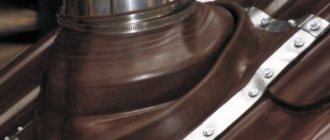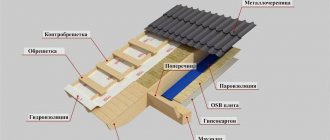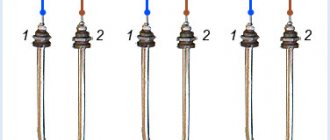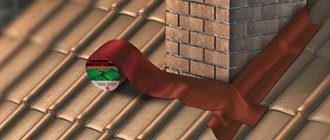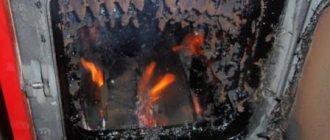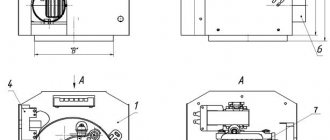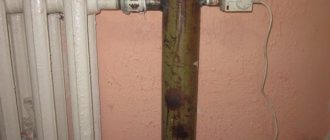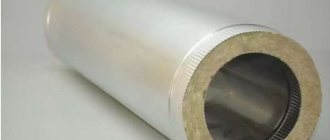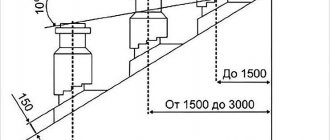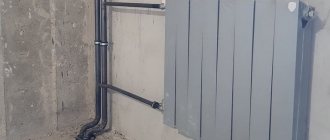Kryza device
Master Flash is a pyramid of rings of different diameters, attached to an elastic base in the shape of a square or rectangle. Each of the rings corresponds to a specific pipe diameter, so this design is universal. The rings can be attached to the base at an angle of 90º, or at an angle of 30 or 45º. Depending on this, the penetration is used for fastening on a flat surface or on an inclined one.
Advice! If there is no corner master flush on sale that matches the angle of inclination of your roof slope, then take a straight one, but of a larger size.
The chimney cover can be made of silicone or rubber. Silicone is a more elastic material and more resistant to high temperatures. But its disadvantage is its lack of resistance to UV radiation, which leads to its shorter service life. If solid fuel is used for combustion, the temperature of the waste products discharged through the pipe will be higher. In this case, the installation of a silicone master flash is required.
Device Features
The designated penetration is represented by a kind of stepped pyramid, which has a base made of special rubber - silicone. Each step has its own diametrical indicator, so you can easily seal pipes of various sizes. The flush master for the pipe is put on directly through the head. Next, it moves to the chimney outlet area and is secured to the roofing surface using self-tapping screws and other fasteners.
There are both silicone and plastic models
The following models of the described devices are very popular:
- Rubber master flush is made from rubber, which is usually classified as synthetic elastomers. The product has a number of advantages. First of all, it is elasticity, excellent protection from excess moisture, and flexibility. The scope of application is the installation of chimneys coming from gas heaters, the operating temperature of which does not exceed 120°C. Otherwise, the device may melt. The production uses rubber with a porous structure such as EDPM; additional components include mineral oils and fat. It is highly resistant to chemical compounds.
- Silicone products are mainly used to equip chimneys, the maximum temperature of which during operation is 120°C. But practice shows that such devices cope well with temperature loads that are twice as high as the indicated value. Such insulation is usually used to equip smoke exhaust ducts coming from heated solid fuel appliances. A significant disadvantage of silicone products is their premature wear when exposed to direct sunlight. However, such insulating devices are not subject to combustion, and to ensure long-term operation they are treated with special compounds.
In this video you will learn how to install master flash:
Advantages and disadvantages
Modern craftsmen prefer installing a master flush for the chimney for the following reasons:
- elasticity, which ensures a tight fit between the pipe and roofing materials;
- a form that allows it to be installed on roofs of a wide variety of shapes and slopes and made of different materials;
- durability and strength, which ensures resistance to mechanical stress, including corrosion;
- tightness achieved due to the tight coverage of the pipe by the upper ring;
- thermal resistance to changes in low and high temperatures;
- wide scope of application - it is possible to install master flash on corrugated sheets, metal tiles, ondulin and other coatings;
- the ability to install master flash in any weather;
- ease of installation of a chimney penetration with your own hands.
- affordable price.
The only downside we can mention is that it is somewhat labor-intensive to install master flash on a roof ridge.
Necessary materials
Before installing the master flush on the roof, check its contents. You will need:
— Master flush for a pipe of the appropriate diameter. When choosing, also focus on the temperature of the exhaust gases, since the choice of material from which the roof is made depends on it.
Advice! When choosing a penetration, keep in mind that a flash master with a reinforced base has a longer service life, but provides insufficient adhesion when installed on metal tiles, corrugated sheets or other embossed roofing materials.
— A plate used to protect the wing from sunlight. It can be purchased at building materials stores or made with your own hands. It looks like an ordinary plate without a bottom.
— Screwdriver, self-tapping screws, metal scissors and heat-resistant silicone sealant
Master flush selection
To choose the right penetration, it is not enough just to know the dimensions of the chimney. Master flash on sloping roofs made of polyprofile, roofing steel without relief, flat tiles, with an angle from 10 to 45º, a roof with a base in the form of a circle or square is selected. For the same roofing materials and a slope of 45-60º, a device with a reinforced flange is selected. In case of a slope of more than 60º, you need to select a seal with an enlarged flange. On flat roofs, perpendicular cuffs will be required. For tiled and slate roofs, penetrations with enlarged flanges are selected. Also, depending on the slope of the roof, choose a corner or straight roof. For some types of chimneys it is impossible to use a standard type of penetration. This may be due, for example, to the fact that the pipe has a square cross-section (wall size up to 15 cm). In this case, a special hood with a clasp is used. Such devices are also used to repair existing insulation. For larger square pipes, a rubber or silicone strip with an aluminum base is used. If it is impossible to use a flash master for compaction, it is recommended to use a special elastic roll material reinforced with aluminum.
In order to decide on the material from which the master flash is made, start from the temperature to which the chimney heats up. In the case of a gas hood, the heating of which does not reach very high temperatures, you can choose a rubber device. A silicone sealant is suitable for a stove chimney.
The Flash Wizard is installed as follows.
First, cut off the upper part so that the diameter of the resulting part is approximately one fifth less than the chimney pipe. This will ensure a tight fit. The resulting structure is placed on the pipe with the base down and moved along the pipe until it fits against the roof. When installing master flush on corrugated sheets and metal tiles, it is better to use a rubber penetration.
The next step will be to secure the resulting structure with sealant. At the very end, you should screw it to the roof using self-tapping screws.
There are several tricks when installing master flash.
- To make it easier to thread the pipes through the roof, cover them with soapy water. This will make pulling easier.
- If you were unable to immediately successfully cut a hole in the master flash, you can try to use it, sealing it tightly with a clamp.
- When buying a sealant for master flush, make sure that it is resistant to moisture.
- There should not be too many self-tapping screws, since in any case the sealant will someday begin to let moisture through, and then it will seep through the holes. Try not to screw self-tapping screws into recesses in the roofing material, as this is where precipitation flows.
- When installing the master flush on a chimney ridge, place its top under the flashing.
There are some features that you need to know before installing master flush on metal tiles. And other roofing materials that are installed with one sheet overlapping another. When performing installation in this case, you need to bring the upper part of the canopy under the nearest adjacent sheet. By performing this maneuver, you will achieve free flow of liquid regardless of the tightness of the penetration connection. This way you can increase the service life of the connection.
Note! Not every chimney is suitable for installing a roof, since in some of them the temperatures of the gases passing through the pipe exceed those permissible for a master flash. You will not have to face this problem in the case of a steel sandwich pipe and chimney connected to a gas-fired condensing boiler, since it does not heat up more than 100º.
If you use a chimney without insulation, as well as boilers running on solid fuel, temperatures can reach 600 º, which can lead to failure of the roof. How to install the master in this case? You need to select a pipe whose size exceeds the diameter of the chimney by about 10-12 cm. Its length should be up to 50 cm, or you can use regular galvanized metal. In the place where the chimney passes through the roof, it must be covered with basalt, and a selected sleeve must be placed on top. The master flash is installed, the dimensions correspond to the sleeve used. The open section of the insulation at the top is covered with a hopper, which is made of galvanized steel. You can attach it using a clamp.
The canopy with fastener is installed according to the following scheme. The top of the cone is also cut to a size 20% smaller than that of the pipe. Then the clasp is removed from the lock. The cuff is wrapped around the pipe, its sides are connected. Then the fastener returns to its place, the teeth tighten. The sealant is then applied to the appropriate area of the roof. Then the fastener and all places that need to be insulated are treated with it.
Having completed the installation, install the plate, thus giving the structure a finished look.
Thus, installing a master flush with your own hands is completely easy to do even for a novice, inexperienced builder. After all, all the tools needed for it can be easily found in many construction stores or even made with your own hands. This will not require special time or material costs from the master. At the same time, the installation of such a device will reliably protect the roof from precipitation, which otherwise could lead to unpleasant consequences.
What is Master Flash?
Master Flash is a kind of sealing cuff with high elasticity. They are used to seal the intersection of pipes and roofs. Different materials are used for manufacturing.
It should be noted that this device is not used as a seal for chimneys without insulation.
The main advantages of Master Flush:
- Tight fit to the pipe walls due to its elasticity.
- Withstands temperature changes.
- Corrosion is not a problem.
- High sealing due to low porosity.
- Returns to its shape after expansion from high temperature.
- High fire resistance.
- Long warranty.
- Installation without special tools.
- Can be installed in any weather conditions.
The main advantage is the reduction in material consumption in this process. No additional waterproofing required.
Differences between seals
Roof seals have become a replacement for pipe aprons. They are similar in design to their predecessors, but have some differences:
- Made of rubber, often silicone, in the form of a tapering cone with a flexible cuff. It ensures a tight connection of the pipe to the roof. In addition, it protects against moisture and dust. The top of the cone follows the shape of the pipe. Connects to the seal at the bottom.
- Flange - base. Made from various materials. Rubberized or silicone base for installation on a roof with massive ribs, has aluminum strips. It allows the flange to take the shape of the profile.
The insulation cuffs for a flat roof are located at a slight angle. An element in the form of a cone with corrugations, which forms the contours of oval holes with gradation in diameter. That is, you can change the angle by tilting at certain intervals. Sometimes it happens that the axis is perpendicular to the base, then the sealant is used for a flat roof.
How to install?
Flexible seals were able to outperform their outdated counterparts in many respects. They are able to withstand different temperature ranges, practically do not need to be repaired, and have a long service life. They are unpretentious in installation. You do not need to have any special skills to install. The upper part of the seal is cut off so that a narrow hole is formed. Then, the cone is put on the chimney. You need to move it down to the very base. To make the process go quickly, it is better to soap or moisten the surface of the pipe.
The method of fixing the flange depends on the roof material:
- Silicone glue or bitumen mastic is used for a flat surface with a roll coating.
- If there is a slope, then the entrance is provided with self-tapping screws.
After installation, the lower part of the flange and the cut of the cone are lubricated with silicone sealant to ensure greater reliability. Sometimes a clamp is used for the top edge. Despite the strength of the fixation, the master flash will be movable. For example, if thermal expansion occurs, the master flash will not lose its tightness. Also, the cuff will behave if shrinkage occurs at home.
Master flush for a chimney: advantages, equipment, installation features
The passage of chimney channels is not without reason called one of the most difficult sections during installation. It is very difficult to make a truly airtight transition and protect your home from fire. Previously, they used various tricks, such as asbestos, galvanized sheets, bitumen and the like. As a rule, the result could last only a few months, and rarely a full season. All due to the characteristic climatic features. Therefore, today, more and more respect and reliability are given to the sealant called master flush for the chimney.
With the help of such a simple device, a person unfamiliar with construction can carry out penetrations in the roofing even with his own hands.
What is a master flush?
Thanks to such a device, the chimney roof gains elasticity; the master flush is designed to design transitions to the roof. Master flash is produced in the most common configurations and formats; in addition, different sizes and shapes are possible. Today, manufacturers are ready to offer rubber seals for roofs made of tiles, corrugated sheets, slate, and the like. Such systems have come, so to speak, to replace the classic “aprons”; they are often made of special rubber labeled EPDM or silicone. The cuff allows for a hermetically sealed connection to the pipe, excluding the penetration of even dust.
The design also has a flange, a device that serves as a base and is also made of rubber. Along the perimeter, for reliable fastening, the base has an aluminum or galvanized tape, which allows not only to create the necessary relief identical to the roof, but also to install the “apron” tightly and, most importantly, hermetically.
Peculiarities
During installation, some nuances and problem cases may arise, which will be discussed below:
- Master flush can be installed both on a pitched roof and on a flat one. If the roof is flat, then you can use a roof in which the axis of the cone is located perpendicular to the plane of the base. And if the roof is pitched, then it is recommended to use those options in which the axis of the cone is located at a certain angle of inclination to the plane of the base.
- If the roof has an intermittent structure, that is, it has many overlaps, then the upper part of the master flush base must be laid under the nearest sheet, and the lower part must be reinforced with self-tapping screws . This will ensure that water, flowing from top to bottom, will not touch the seams of the foundation fastenings to the roof surface.
- If the roof is laid from corrugated sheets or slate, then it has rows along which water flows down. In this case, it is not recommended to tighten the screws for fastening the master flush in the rows of the roof along which water flows.
- As already mentioned, Master Flash, which is based on silicone, is susceptible to the harmful effects of ultraviolet rays. But this problem can be avoided. To do this, a special shape is made from galvanized steel, in the form of a “bowl without a bottom.” It is then placed over the master flash to protect against ultraviolet rays. In this case, it is necessary to select the diameter so that it does not dangle from the wind.
- When installing a master flash on a roof ridge, the upper part should be installed under the ridge masonry.
- It is not recommended to screw too many screws onto the base.
- Sometimes the pipe heats up to 600-650 degrees, in which case the master flush will simply begin to melt. To avoid this, you need to wrap this section of the pipe with bitumen, then put a metal sleeve made of galvanized steel on top of it. Master flash is selected according to the size of the sleeve. In this case, you can also use the so-called “sandwich pipes”. To do this, the chimney must be multi-layered, as a result of which the outer layers heat up less.
Advantages and disadvantages
The chimney roof seal has the following characteristics:
- It is elastic, which allows you to create shapes identical to the overlap and make a hermetically sealed joint.
- Withstands flash and temperature changes over a fairly wide range.
- Inert, that is, they have a high degree of resistance to oxidation.
- Extremely low porosity of the surface and structure, resulting in amazing tightness.
- Fire resistance.
- It is possible, even after exposure to temperature, to take the same shape and configuration.
- Wear resistance within 30 years.
- No special tools are required for installation.
- There are no contraindications due to weather conditions during installation.
Master Flash for a chimney with your own hands - device and installation
The roof is built in order to protect the house from precipitation, but it will not be able to perform this function if the smallest cracks and gaps between the roofing material and the adjacent elements are not eliminated. The outlet of the chimney pipe needs more careful sealing. Since the size of the hole in the slope is 2-5 centimeters larger than the diameter of the smoke exhaust channel, a gap is formed between them, through which water penetrates into the rafter frame. To prevent leaks, bitumen mastic, cement mortar and sealants are used, however, the effectiveness of these materials decreases over time. To solve the issue of insulating the joint between the pipe and the roof once and for all, experienced roofers advise installing Master Flash elastic penetration.
Device
The Master Flash penetration is a stepped pyramid on a rectangular base made of silicone or rubber. Each of the steps has a corresponding diameter, so it is used for waterproofing pipes of any diameter. The Master Flash penetration is put on through the head, moved to the base of the chimney outlet to the roof and secured to the surface of the slope using self-tapping screws. Manufacturers offer models made from two different materials:
- Made of rubber. Master Flash is made from ethylene-propylene rubber, which belongs to the class of synthetic elastomers, has high elasticity, flexibility, and a high degree of moisture protection. They are used for chimneys in which the gas temperature is not higher than 100-120 degrees, since this material melts and burns. EDPM rubber has a porous structure and has low resistance to chemical compounds that contain fat and mineral oils.
- Made from silicone. Master Flash made of silicone is used for chimney pipes whose operating temperature exceeds 120-130 degrees. They tolerate heating well up to 220-240 degrees. Therefore, they are used to isolate the smoke exhaust duct of devices operating on solid fuel. Silicone products do not tolerate direct sunlight well, so they last less. This type of passage isolation device is non-flammable.
Important! Manufacturers produce straight Master Flash penetrations, which are used for installation on flat roofs, and angular penetrations (30 and 45 degrees), intended for pitched roofs. When choosing a model for installation with your own hands, be guided by the slope of the slopes; if only straight lines are available, take a larger penetration.
Installation Rules
Before starting installation work, you should prepare all the necessary materials. To fasten the structure you will need about six self-tapping screws, a screwdriver or screwdriver, sealant, and special scissors. After preliminary preparation, you can begin installation.
If you carry out the work yourself, you should study the installation instructions and follow all instructions. The algorithm of actions is simple and does not present much difficulty:
- The upper part of the device cone is cut so that the diameter of the lumen is 20% less than the cross-section of the chimney pipe. In this case, the roof will fit tightly to the chimney.
- Excess rubber or silicone is cut off as evenly as possible with special scissors.
- At the next stage of work, the Master Flash is put on the upper end of the pipe.
- Then it is slowly advanced, directing it down to the roofing surface. To improve sliding, it is recommended to moisten the pipe.
- The lower base is attached to the roof surface with sealant.
- For reliability, the structure is secured with self-tapping screws.
- An elastic sealant is applied along the perimeter of the edge of the upper cut.
This completes the installation of the cuff. Now all gaps between the pipe and the passage hole in the roof are hermetically sealed with a sealant. Mounting a device with a rigid edge is done in the same way.
Equipment
Using the Master Flash penetration is the simplest way to insulate the joint between the chimney and the roof. Its installation takes no more than 30 minutes, and it lasts at least 15 years. To do the installation yourself, you will need:
- Master Flash penetration of the appropriate size made of silicone or rubber. Choose a model based on the diameter of the chimney pipe and the temperature of the gases inside it. Pay attention to the base of the product: products with a metal-reinforced flange last longer, however, it provides a poor fit to textured roofing materials.
Note! At each penetration stage, the corresponding pipe diameter is indicated. To prepare the Master Flash for installation with your own hands, you need to accurately determine the size of the chimney and cut the device according to the mark with ordinary scissors. Experienced roofers say that the hole in the flexible penetration should be 20% smaller than the pipe.
Installation of seal
On a flexible basis
On metal roofs, cuffs with a flexible base are used. The installation itself looks like this:
- Determine the location of the cut. Do not forget that the cutting diameter will be 20 percent smaller than the chimney;
- To ensure that the cut part is even, find roofing scissors;
- We soap the chimney pipe with soap or moisten it with water. This is done to make it easy to put on the cuff;
- The installation is done, then we draw lines along the edges of the base;
- We lift the seal and apply the adhesive;
- We press;
- We apply sealant where needed.
If there are metal strips at the edge of the seal, then installation is similar to the installation of soft equipment. The following items are added. Before installation, the base coating must be profiled so that it adheres well to the roof. To work, you will need hexagon-shaped self-tapping screws. Fasteners are screwed onto the bottom of the profile.
A special seal design for roofs with a technological gap is needed when it is not possible to attach a seal to the chimney. They are often used for repair work on old chimneys.
The installation will be like this:
- Using strong scissors, cut off the upper cone to less than 20% of the chimney cross-sectional size.
- Unscrew the shutter and wrap the pipe.
- Align the gap in the seal and close the locking system.
- Raise the edges of the base to apply silicone sealant to the roof.
- Press everything with force, spread the adhesive solution on the desired areas, the locking system.
For tile or slate roofs, seals are made with a lead or aluminum flange. The cone system is also cut off. This is done in order to ensure good adhesion of the remaining cone to the chimney.
Installation of master flush on corrugated sheets is carried out in the same way as installation on a tile roof.
When installing, remember the following recommendations:
- In order for the seal to pass through the pipe easily, you need to coat the pipe with a substance that will support sliding.
- If you made a mistake with cutting a hole on the cone, well, you need to throw out the element.
- We take waterproof sealant for sealing. We screw screws on top of the sealant. As time passes, the sealant will perform its duties worse. The self-tapping screws will come to work. But, you don’t need to screw in a lot of screws. A large number of holes for screws increases the likelihood of moisture getting inside.
- When we place the kriza on the ridge, its top needs to be placed under the ridge cap.
- If the pitched covering is not uniform, with overlaps, you need to move the top of the seal under the adjacent part. This action promotes continuous flow of water, regardless of how well the roof sealing is done. This will ensure long, continuous operation.
- Installation of master flash on corrugated sheets is carried out similarly to a tiled roof.
The Master Flash roof penetration is compatible with all types of roofing. Goes well with corrugated roofing surfaces. Made of thermo silicone, EPDM rubber (vulcanized). A huge selection of options for use: cable ducts, ducts, ventilation pipes, chimney pipes.
The roof is reliably protected from water and snow. Guaranteed heat resistance of vulcanized EPDM rubber: 185C
On a flexible basis
Seals with a flexible base are used on metal roofs.
- You need to choose a place for the cut. We must not forget that it should be 20 percent narrower than the diameter of the chimney.
- For this you need roofing shears. Try to keep the cut part straight.
- The surface of the chimney must be moistened. Then, tighten the seal onto the pipe.
- After installation on the roof, you need to draw a line along the edges of the base.
- Lifting the seal, apply adhesive.
- Press.
- Apply sealant to all required areas.
Advantages
Elastic products for sealing the passage of pipes through the roof have earned the trust of craftsmen and have become more popular than traditional methods of sealing gaps. Master Flash is optimal for DIY installation due to the following qualities:
- Tightness. It reliably protects the gap between the pipe and roofing materials from moisture penetration, preventing the possibility of leaks.
- Elasticity. Due to their flexibility, rubber penetrations tightly cover the pipe and fit tightly even to profiled roofing materials. These devices are suitable for roofs of any shape and slope.
- Versatility. It is suitable for roofs covered with corrugated sheets, metal tiles, roofing felt, slate and bitumen shingles.
- Easy to install. Do-it-yourself installation can be done in 10-15 minutes alone; even an inexperienced craftsman can do this work.
- Durability. Due to their resistance to temperature changes, chemical influences, and moisture, rubber penetrations have a long service life and do not require frequent replacement.
- Strength. Products made from high-quality rubber have a durable structure that is resistant to mechanical damage.
- High temperature resistance. The maximum permissible temperature at which silicone can be used to insulate a chimney meta-inlet is 220-240 degrees. This heat resistance allows Master Flash to be used for heating devices using any type of fuel.
Important! In some cases, the elasticity of Master Flush is the main advantage over other types of insulation. Only rubber and silicone penetrations have the ability to compensate for changes in the dimensions of the roofing material under the influence of thermal expansion.
Types of roofs and their area of application
There are the following types of roofs:
- ridge;
- single-slope design;
- decyl;
- decylless;
- universal.
Let's look at some of them in more detail.
Skate. It is used during installation work and installations with access to the outside through the roof through the ridge. This insulation option allows installation above the roof with an overhang of only 500-600 mm
It is important that the rules of wind support are not violated.
There's no point in talking about installation. The photograph clearly shows the working parts. It is better to watch the video material presented by specialists on our website about installation possibilities.
Watch the video
Watch the video
Terms of Use
Elastic rubber penetration Master Flash is the best option for waterproofing the gap where the chimney passes through the roof. However, it is not suitable for all cases. Professional roofers and manufacturers recommend using this device for DIY installation on the following types of smoke exhaust ducts:
- Sandwich chimneys. Between the two galvanized steel contours of these pipes there is a thermal insulating layer of basalt fiber. The insulation retains heat in the inner pipe, so the outer surface of the chimney remains cool. Rubber models are used to waterproof sandwich pipes.
- Stainless steel chimneys. Stainless steel chimneys that remove combustion products from solid fuel stoves are heated to high temperatures. Therefore, heat-resistant silicone penetrations are used to seal the target between the roof and the pipe. The use of conventional rubber models is possible if the chimney is connected to a condensing-type gas boiler.
Note! If you want to insulate the outlet of a bare pipe with Master Flash, you can use a special sleeve. A section of 50-100 cm is cut out of a pipe whose diameter is larger than that of the chimney. The section of the chimney passing through the roof is tightly wrapped with fireproof material, and then the sleeve is put on and secured with a steel clamp.
Each passage of Master Flash is supplied with detailed instructions to facilitate DIY installation. Since the work is performed at height, you should follow safety precautions, use a safety rope and a helmet. Installation is performed as follows:
- If a protective cap is placed on the pipe, it is removed. The top of the penetration is cut with a knife to the required diameter.
- Pull the device onto the pipe through the head. If the penetration is too slow, the pipe is treated with a soap solution, which makes the task easier.
- A heat-resistant silicone-based sealant is applied to the base of the penetration in an even, thick layer and pressed against the surface of the roofing material.
- Additionally, secure the base using self-tapping screws with a press cap. Do not overdo it with the number of screws, because when the sealant is washed off, water will begin to flow into the holes.
- If the installation takes place on a roof made of bitumen shingles, the upper part of the base is tucked under the covering elements.
- A decorative plate in the color of the roof is installed on the penetration.
Important! If, while cutting the penetration, you made a mistake and made a hole of a larger diameter or damaged the device, you can try to secure it to the pipes using sealant and a steel clamp.
About the conditions of use
An elastic rubber penetration would be an excellent option for ensuring reliable waterproofing in the chimney passage area. But it will not be appropriate in all cases. Experienced experts say that such a device is suitable for equipping the following smoke exhaust channels:
- Sandwich chimneys. These pipes have two contours made of durable galvanized steel, between which there is a layer of thermal insulation, most often represented by basalt fiber. This material retains heat through the inner pipe, which is why the outer part of the chimney does not warm up much, remaining practically cold. Optimal waterproofing of sandwich pipes - rubber models.
- Stainless steel chimneys, through which combustion products are discharged into the external environment when heating premises, are distinguished by the fact that they heat up very much. It is customary to fill the gaps between them and the roofing surface with heat-resistant penetrations made of silicone. In this case, master flush rubber models are also suitable, but if the chimney is powered by a gas condensing boiler.
